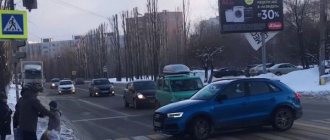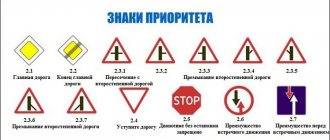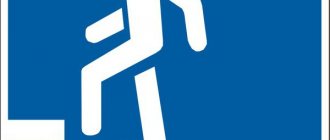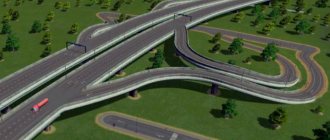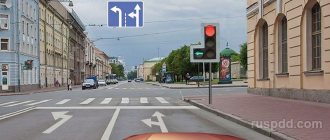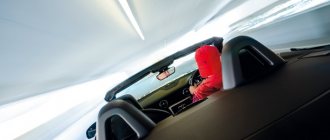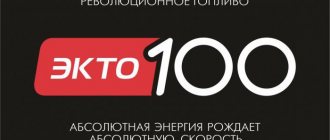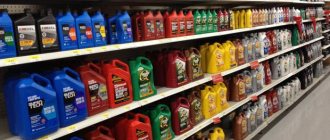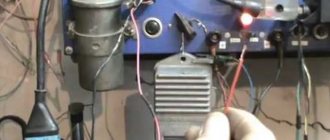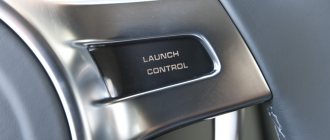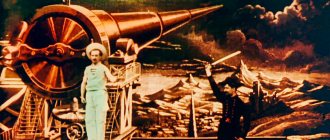Traffic rules are distinguished by the variety of symbols that are placed on the side of the road. All signs are divided into informational, priority, service and prohibitory. The last group is the most important, as it reflects the rules, the violation of which is unacceptable. Categories of signs differ in shape, color and content. Prohibiting traffic signs are presented in the form of a circle with a red border. They are primarily aimed at drivers, but there are also several symbols for pedestrians, in particular, a prohibition on crossing. All prohibition signs can be divided into several groups.
Traffic ban
There are several symbols that contain traffic prohibition information. The first of them, under code 3.1, is the so-called brick. It looks like a red circle with a white line in the middle. No vehicles are allowed to drive under it.
The main places for its installation include:
- Intersections followed by one-way traffic.
- Repair work areas.
In some cases, public transport is allowed: trolleybuses, buses and trams.
Sign 3.2 is also associated with a prohibition of movement, but assumes a wide range of people who have the right to travel under it. It looks like a white circle with a red border without any drawings or markings on it.
The following types of vehicles are allowed to travel under this symbol:
- public transport, most often we are talking about minibuses;
- cars carrying people with disabilities that have a “disabled person” sign on the window;
- cars of citizens living or working in the area covered by the sign;
- postal service.
The above restrictions are also introduced for sign 3.3, prohibiting the passage of motor vehicles.
A passenger car is depicted on a white circle with a red border. The sign allows the movement of mopeds, bicycles and other vehicles that are not included in the category of mechanical ones. If the driver of the car has the right of passage, then he must prove it with documents, for example, by presenting a passport with registration or an identification card of an employee of the enterprise.
The next sign, 3.4, applies exclusively to freight vehicles weighing over eight tons. It shows a truck in a white circle with its weight indicated in white numbers. If the weight is not indicated, then the limit is three and a half tons.
The exceptions are:
- Trucks traveling without a trailer and weighing no more than twenty-six, serving an enterprise, the only entrance to which is marked with a sign.
- Postal service vehicles.
Prohibition signs photo 3.5-3.9 are symbols reflecting additional travel restrictions. On the white circle, the corresponding vehicles are drawn with a red border and black.
They sequentially apply to:
- motorcycles, does not affect mopeds;
- tractors, including graders and other self-propelled vehicles;
- trailer, towing a vehicle is also prohibited;
- horse-drawn carts, cattle driving, use of other pack and riding fauna;
- Bicycles and mopeds, it is permissible to drive them with your hands, but not to ride them.
The list of symbols associated with the prohibition of movement is completed by sign 3.10 - for pedestrians; it also applies to a cyclist who is driving his vehicle. It only applies in one direction and applies to anyone planning to cross the road. Signs prohibiting traffic, pictures with explanations are in the traffic rules.
Today, most offenses are recorded by video cameras installed in inconspicuous places. It is not recommended to take risks and rely on the absence of traffic police officers. Even if they are not there, the registrar will take direction finding.
Prohibition signs
Prohibition signs introduce or remove certain traffic restrictions.
3.1 “Entry is prohibited.” Entry of all vehicles in this direction is prohibited. (a comment)
3.2 “Movement is prohibited.” All vehicles are prohibited. (a comment)
3.3 “The movement of motor vehicles is prohibited.” (a comment)
3.4 “Truck traffic is prohibited.” The movement of trucks and vehicle combinations with a permissible maximum weight of more than 3.5 tons (if the weight is not indicated on the sign) or with a permissible maximum weight more than indicated on the sign, as well as tractors and self-propelled vehicles is prohibited. (a comment)
Sign 3.4 does not prohibit the movement of trucks intended for transporting people.
3.5 “Motorcycles are prohibited.” (a comment)
3.6 “Movement of tractors is prohibited.” The movement of tractors and self-propelled vehicles is prohibited. (a comment)
3.7 “Moving with a trailer is prohibited.” It is prohibited to drive trucks and tractors with trailers of any type, as well as tow motor vehicles. (a comment)
3.8 “The movement of horse-drawn carts is prohibited.” The movement of horse-drawn carts (sleighs), riding and pack animals, as well as the passage of livestock is prohibited. (a comment)
3.9 “Bicycles are prohibited.” Bicycles and mopeds are prohibited. (a comment)
3.10 “Pedestrian traffic is prohibited.” (a comment)
3.11 “Weight limitation”. The movement of vehicles, including combinations of vehicles, the total actual weight of which is greater than that indicated on the sign, is prohibited. (a comment)
3.12 “Limitation of mass per vehicle axle.” It is prohibited to drive vehicles whose actual weight on any axle exceeds that indicated on the sign. (a comment)
3.13 "Height limitation". The movement of vehicles whose overall height (with or without cargo) is greater than that indicated on the sign is prohibited. (a comment)
3.14 "Width limitation". It is prohibited to drive vehicles whose overall width (laden or unladen) is greater than that indicated on the sign. (a comment)
3.15 "Length limitation". The movement of vehicles (vehicle trains) whose overall length (with or without cargo) is greater than that indicated on the sign is prohibited. (a comment)
3.16 “Minimum distance limitation.” It is prohibited to drive vehicles with a distance between them less than that indicated on the sign. (a comment)
3.17.1 “Customs”. It is prohibited to travel without stopping at a customs office (checkpoint). (a comment)
3.17.2 "Danger". The further movement of all vehicles without exception is prohibited due to a traffic accident, accident, fire or other danger. (a comment)
3.17.3 "Control". Driving through checkpoints without stopping is prohibited. (a comment)
3.18.1 “Right turns are prohibited.” (a comment)
3.18.2 “Left turns are prohibited.” (a comment)
3.19 “Turning is prohibited.” (a comment)
3.20 “Overtaking is prohibited.” It is prohibited to overtake all vehicles except slow-moving vehicles, horse-drawn carts, mopeds and two-wheeled motorcycles without sidecars. (a comment)
3.21 “End of the no-overtaking zone.” (a comment)
3.22 “Overtaking by trucks is prohibited.” It is prohibited for trucks with a permissible maximum weight of more than 3.5 tons to overtake all vehicles. (a comment)
3.23 “End of the no-overtaking zone for trucks.” (a comment)
3.24 “Maximum speed limit.” It is prohibited to drive at a speed (km/h) exceeding that indicated on the sign. (a comment)
3.25 “End of maximum speed limit zone.” (a comment)
3.26 “Sound signal is prohibited.” It is prohibited to use sound signals, except in cases where the signal is given to prevent a traffic accident. (a comment)
3.27 “Stopping is prohibited.” Stopping and parking of vehicles is prohibited. (a comment)
3.28 “Parking is prohibited.” Parking of vehicles is prohibited. (a comment)
3.29 “Parking is prohibited on odd days of the month.” (a comment)
3.30 “Parking is prohibited on even days of the month.” (a comment)
When signs 3.29 and 3.30 are used simultaneously on opposite sides of the roadway, parking is permitted on both sides of the roadway from 19:00 to 21:00 (rearrangement time).
3.31 “End of the zone of all restrictions.” Designation of the end of the coverage area simultaneously for several signs from the following: 3.16, 3.20, 3.22, 3.24, 3.26 - 3.30. (a comment)
3.32 “The movement of vehicles with dangerous goods is prohibited.” The movement of vehicles equipped with identification signs (information plates) “Dangerous cargo” is prohibited. (a comment)
3.33 “The movement of vehicles with explosive and flammable cargo is prohibited.” The movement of vehicles transporting explosives and products, as well as other dangerous goods subject to marking as flammable, is prohibited, except in cases of transportation of these dangerous substances and products in limited quantities, determined in the manner established by special transportation rules. (a comment)
Signs 3.2 - 3.9, 3.32 and 3.33 prohibit the movement of the corresponding types of vehicles in both directions.
The signs do not apply to:
- 3.1 - 3.3, 3.18.1, 3.18.2, 3.19, 3.27 - for route vehicles;
- 3.2, 3.3, 3.5 - 3.8 - on vehicles of federal postal service organizations that have a white diagonal stripe on a blue background on the side surface, and vehicles that serve enterprises located in the designated area, and also serve citizens or belong to citizens living or working in the designated area. In these cases, vehicles must enter and exit the designated area at the intersection closest to their destination;
- 3.4 - for vehicles of federal postal organizations that have a white diagonal stripe on a blue background on the side surface;
- 3.28 - 3.30 - on vehicles of federal postal organizations that have a white diagonal stripe on the side surface on a blue background, as well as on taxis with a taximeter on;
- 3.2, 3.3, 3.28 - 3.30 - for vehicles driven by disabled people of groups I and II, transporting such disabled people or disabled children.
The effect of signs 3.18.1, 3.18.2 extends to the intersection of roadways in front of which the sign is installed.
The coverage area of signs 3.16, 3.20, 3.22, 3.24, 3.26 - 3.30 extends from the place where the sign is installed to the nearest intersection behind it, and in populated areas, in the absence of an intersection, to the end of the populated area. The effect of the signs is not interrupted at exit points from areas adjacent to the road and at intersections (junctions) with field, forest and other secondary roads, in front of which the corresponding signs are not installed.
The effect of sign 3.24, installed in front of a populated area indicated by sign 5.23.1 or 5.23.2, extends to this sign.
The coverage area of signs may be reduced:
- for signs 3.16 and 3.26 using plate 8.2.1;
- for signs 3.20, 3.22, 3.24 by installing signs 3.21, 3.23, 3.25 at the end of their coverage area, respectively, or using plate 8.2.1. The coverage area of sign 3.24 can be reduced by installing sign 3.24 with a different maximum speed value;
- for signs 3.27 - 3.30 by installing repeated signs 3.27 - 3.30 with plate 8.2.3 at the end of their coverage area or using plate 8.2.2. Sign 3.27 can be used in conjunction with marking 1.4, and sign 3.28 - with marking 1.10, while the coverage area of the signs is determined by the length of the marking line.
The effect of signs 3.10, 3.27 - 3.30 applies only to the side of the road on which they are installed.
- Appendix 1. Road signs :1. Warning signs2. Priority signs 3. Prohibitory signs 4. Mandatory signs5. Signs of special regulations6. Information signs7. Service marks8. Additional information signs (plates)
Each sign has a more detailed description. To read it, follow the link - “comment” next to the sign. If you have any questions, write, we will try to answer on the online traffic rules pages.
The content of the article:
- prohibition signs
- prohibitory road signs
- prohibiting traffic signs
- PROHIBITION SIGN
Limiting parameters
There are a number of signs containing information regarding the maximum permissible indicators.
These include the following limitations and explanations:
- mass 3.11 – applies to all vehicles traveling along a certain area;
- weight on axle 3.12, installed together with proposals for detour 6.15.1, due to the fact that heavy load damages the roadway;
- height 3.13 and width 3.14 - fixed at tunnels, bridges or arches, where a larger vehicle than indicated in the sign is not able to pass;
- length 3.15 – important for truck drivers and obliges them to find a detour;
- the minimum distance between cars is 3.16 - half of two cars are drawn on it and the number is in meters - used on surfaces where a strong load on one point leads to collapse or destruction, for example, on bridges, crossings.
If instead of a white circle there is a yellow one, then the symbol is temporary, for example, during the period of repair work. Such signs have priority over ordinary ones.
In most cases, restriction signs are placed directly for the safety of the drivers themselves, but sometimes they are also aimed at taking care of the road surface. Ignoring them is unacceptable.
Automotive lawyers advise
If you happen to pass under this sign, under no circumstances should you follow to the end of the prohibited section. It is imperative to make a stop. Let it be a post office, a store, an educational institution, an office, etc. And then leave the forbidden territory through the same sign. Such driver actions do not violate the law. If, nevertheless, the vehicle is stopped by traffic police inspectors, you will need to confirm the purpose of the trip.
Here I would like to remind you that in the rules of DD, road traffic is considered the organized movement of vehicles on roads specially equipped for this purpose. The second condition for movement is the intersection of two or more intersections. Theoretically, a “No Traffic” road sign implies a ban on transit traffic from one intersection to another. Therefore, entering and stopping on this section of the road is not a violation.
Special zones
A small list of road signs reflects a ban on driving in a certain place; in some cases, the driver must take a different route, and sometimes simply go through a checkpoint as directed by employees.
These types of symbols include:
- Customs 3.17.1 – on the standard form of the prohibition sign the concept itself and its English translation “custom” are written. It is installed immediately before the entrance to the point and requires passing through passport control to continue movement.
- Danger 3.17.2 - abroad the symbol says danger - prohibits entry to everyone, as there is a threat to health and life, for example, in case of major fires or natural disasters.
- Control 3.17.3 or stop – placed in places where for any reason you need to stop and present a pass or document. It is also sometimes present at the entrance to the toll road.
All of the above symbols are required. Acceptable, and not always, exceptions are special services vehicles: ambulance, fire, police.
In addition to the fact that you must stop in front of the indicated symbols, you should not leave the car without permission and do not put the vehicle in reverse. For example, in the border zone this is especially critical.
Special characters
Driving without stopping is prohibited for all vehicles when signs 3.17.1 3.17.3 are in effect. As a rule, they are re-installed at a distance of 500 meters from one another, but no closer than 300 meters to the stopping point. Used with warning signs. Sometimes they are installed temporarily (the color is yellow, for example quarantine).
Road sign 3.17.1 - indicates Federal Customs checkpoints.
3.17.3 - always installed on the roads in front of the traffic police post. The entrance to the protected area is also marked with this sign. On toll roads you also cannot drive past it without stopping. The barrier will only open if payment has been made.
The passage is closed even after stopping when signs are installed:
- 17.2 - further movement threatens the life and health of drivers and passengers;
- 32 and 3.33 – the transportation of explosive and flammable materials and objects by all types of vehicles is prohibited (allowed only with a special permit on vehicles with the appropriate identification marks).
If the rules prescribed by these three signs are violated, it may be too late to impose a fine.
Rarely used
There are signs that are rarely used nowadays, but you should definitely know them. These include:
- 3.9 – travel on bicycles and mopeds is prohibited;
- 3.10 – pedestrian traffic is prohibited.
Bicycles and mopeds are allowed to be driven on the sidewalk (but not ridden!). You cannot drive on the road, you can only drive along the side of the road, on the right in the direction of movement of the main vehicles. The fine for violating traffic rules is 500 rubles.
Today in large cities you will not see road sign 3.8 - horse-drawn carts are prohibited from driving. In small cities and towns adjacent to intercity highways, it is used. The restriction does not apply to the transportation of goods, products, mail, etc.
We present personal documents
If there is a road sign 3.2 “Prohibited” in front of a residential area, the traffic police inspector has the right to stop a personal car and ask the driver to present documents. You must show a driver's license, insurance and a passport with a registration stamp at the exact address where you are entering. The explanation that I live here but am registered elsewhere is not accepted. The inspector issues a minimum fine. It will not be assigned if there is a “Disabled Person” sign or sticker on the car. But then you must additionally provide a certificate of disability.
Prohibition of actions
A series of signs that allow movement along a certain area, but establish a ban on certain manipulations on the road. They are placed to warn of danger on the road.
These actions include:
- turn right 3.18.1 or left 3.18.2 - looks like a crossed out arrow to the side - the prohibition is related to movement at a specific intersection, moreover, if you cannot turn left, then turning around is permissible, does not apply to public transport;
- turn 3.19 – crossed out black arrow showing the trajectory of movement when performing an action – allows turning;
- overtaking 3.20 - depicts two cars driving in parallel, one of which is red and the other black - prohibits overtaking of all types of vehicles except slow-moving ones, which include carts, mopeds, and so on.
The last sign is presented in a different form when the second vehicle is a truck 3.22. In this case, it is permissible to manipulate passenger cars. Both signs have special symbols reflecting the end of the ban 3.21 and 3.23. They look like this: on a white circle, without a red border, two cars are drawn in gray, and the entire sign is crossed out with three thin stripes diagonally.
Other restrictive symbols include:
- Speed limit 3.24 - a number is simply indicated on a white background, which reflects the permissible maximum speed in a certain area. The coverage area ends either by canceling 3.25, or by installing a similar sign with a different meaning, or by an intersection.
- Prohibition on sound signal 3.26 – a crossed out pipe is drawn on the symbol. Does not allow sounding a horn on a traffic area, with the exception of cases when this is required to prevent an accident.
In fact, all of the described traffic prohibition signs have temporary analogues, the difference being that they have a yellow rather than a red background.
Russian road safety legislation allows speeding by twenty kilometers. This error eliminates the chance of discrepancies between the indicators in the car and the radar. In other countries, for example, in Belarus - only ten km.
Movement requiring a stop
Even a child knows which road sign prohibits driving without stopping. This is a “STOP” sign, or “No driving allowed.” It is usually installed before:
- the beginning of a special road zone;
- stop line;
- the beginning of the road being crossed.
The sign requires a mandatory stop. Ignoring will result in penalties. The amount varies depending on the location of the violation and the type. For example, in rural areas the fine will be minimal, but in a metropolis you will have to pay the maximum.
DD rules suggest that the same road signs can be read in different ways. “Driving without stopping is prohibited,” for example, installed at a railway crossing, obliges the driver to stop the car before the sign. Stopping behind it is punishable by a fine, which will not happen if the vehicle stops behind the same sign, but installed in front of the intersection.
Parking rules
A whole series of signs is dedicated to the norms and principles of parking and parking of vehicles.
Their list includes:
- Stopping is prohibited 3.27 - a blue circle with a red border and a strikethrough in the form of the letter X of a similar color. Applies to the lane on which it is installed. The coverage area is either limited by the intersection or by a certain distance indicated by a sign below the symbol.
- Parking prohibited 3.28 – the external difference from the previous sign is based on the fact that there is only one stripe. As for the rules, it is worth paying attention to the concepts of parking and stopping.
- Parking is prohibited depending on the days - even on 3.29 and odd on 3.30 - one or two vertical stripes are depicted on a blue background and this is crossed out. The rest of the rules are similar.
Let's say there is a sign on one side of the street with one white vertical stripe crossed out, for drivers this means that parking is allowed here on even numbers, for example, second, fourth, and so on.
Stopping under a prohibitory sign is possible only in case of force majeure. For example, a sharp deterioration in the driver’s health or a car breakdown. In such a situation, it is mandatory to turn on the emergency signal and place a special triangle behind the vehicle.
Road sign “No traffic”
The “No Traffic” sign, in accordance with the international Standard, belongs to the group of prohibitory signs and is described in paragraph 3.2 of Appendix 1 to the Russian Traffic Rules.
What does the sign look like?
The design of the sign is a white reflective circle with a diameter of 0.7 meters, with a red border along the outer edge (GOST 9.401-91). The sign can be installed in several ways:
Attached to special racks made of pipes, steel supports or channels.
Placed on lighting, tram or trolleybus poles.
Hanged on cables stretched between lighting poles on both sides of the road.
Placed on a metal hoop encircling a tree trunk.
This designation cannot be found on busy highways, intercity highways and expressways. Most often it is placed at the entrances to courtyards, in front of park areas, in service parking lots, near reservoirs, attractions, that is, where it is necessary to give pedestrians space to move comfortably. In fact, the sign warns drivers that there is a pedestrian zone further ahead.
In the area where the sign is located next to the roadway, the movement of any vehicles moving in all directions is prohibited.
The coverage area of the “No Traffic” sign begins at the installation site and ends at the nearest intersection relative to vehicle traffic.
According to the traffic rules, a road sign prohibiting movement means that movement is limited in both directions, so it is not installed before entering a one-way road. In this case, a “brick” is installed. The fine for driving under a “no traffic” sign is relatively small, because the violator’s vehicle does not interfere with other vehicles. Driving on a “brick”, in turn, threatens with deprivation of rights, because in this case, the driver creates potentially dangerous conditions for other road users.
About the “no through passage” sign
Until recently, the sign in question had the name “Through Passage”. This name sometimes misled not only drivers, but also traffic police officers. Many people mistakenly believed that sign 3.2 does not prohibit entry and subsequent parking in the area covered by the sign. In fact, this is not so: any entry of any vehicle and movement in any direction within the area of the sign is prohibited, except for the exceptions that will be given below.
Additional signs
An important sign is the cancellation of all restrictions 3.31 - a white circle without a border with three thin diagonal gray lines. It happens that many restrictions are placed within a certain area; it is easier to put one symbol after the problem area than to remove restrictions on all of them. When passing such a sign, the driver must follow the general speed limit rules and follow the road markings.
Two more prohibitory signs are:
- movement of vehicles with dangerous goods - the rear view of the truck is shown, which is indicated in yellow - does not allow the transport of hazardous substances in a limited area,
- passage of a car with explosives - a black car with a fire on the roof is drawn - the principle of the prohibition is similar to the previous road symbol.
In general, dangerous goods include: flammable substances, peroxides, poisons, compressed gases, radiation and other toxic elements.
The transportation of toxic substances in itself is permitted subject to compliance with safety standards. But in certain places their transportation is not possible, for example, due to a possible reaction with elements located in the area.
Installation locations
Depending on the purpose, the prohibitory sign “No movement” can be installed:
- on any section of the road or street in order to designate an area for pedestrians;
- on a roadway or street in order to temporarily block the movement of vehicles (for example, during a mass event);
- anywhere on a road or city highway in order to block traffic in the area being repaired;
- before entering an alley ending in a dead end, or into a yard with one entrance for the purpose of warning (installed together with a sign indicating a dead end);
- in front of checkpoints and/or entrances to the official territory of organizations or enterprises.
Features of the use of signs
It was stated above that in most cases, prohibitory road signs with an explanation are presented in the form of a white circle with a red border and a black or colored symbol inside. Along with this, there are four symbols on a blue background related to parking and several signs with gray lines reflecting the end of the ban.
In addition to the general rules, there are a number of important exceptions and nuances of application. Let's look at the basic ones:
- Road users equipped with sound and light signals have the right to ignore all prohibiting symbols. These include ambulances, police and fire departments.
- Some signs apply to all vehicles, including customs, control, danger, as well as speed limits and overtaking rules.
- Such symbols as prohibitions on turning left and right, as well as on stopping, do not apply to minibus taxis. In most cases, in relation to the latter, there are special markings indicating the area permitted for public transport.
- Services engaged in mail delivery have the right to ignore signs prohibiting movement in certain places, as well as parking rules.
- When transporting persons with disabilities, it is permissible to ignore the symbols associated with unauthorized parking, as well as restrictions on movement, but this does not apply to the “brick”. It is important that the car has an appropriate sign indicating the disability of the driver or passenger.
- Symbols related to the ban on entry into certain territories are not relevant for citizens living there or working at an enterprise, the path to which lies through the only road. Recently, such signs have been placed in residential areas to reduce the flow of cars inside courtyards.
- As for taxi drivers, in general they are equal to ordinary car owners, but if their taximeter is turned on, then they have the right to violate the instructions of the parking sign.
- When a symbol prohibiting overtaking is installed, the rules allow for the possibility of passing vehicles whose speed is below thirty kilometers per hour.
When studying traffic rules, it is advisable to pay attention to details and exceptions. If you have doubts about a particular symbol on the road, it is better to avoid a potential offense.
All prohibitions are more or less associated with a risk to life and health. For example, overtaking is most often prohibited on winding or mountain roads, where oncoming cars are not immediately visible.
The difference is obvious
Driving schools explain in detail the essence of the “No Entry” (brick) and “No Traffic” signs. The first one prohibits absolutely everyone from entering a certain part of the road from a specified place (including disabled people and residents of the territory located behind the prohibitory sign). The relaxation has been made only for route transport. But from any other place, entry to this site is completely free.
A “no traffic” road sign introduces a categorical ban on the movement of vehicles in a certain area. Purely theoretically, this sign has no territorial restrictions. The beginning of the prohibition is the place where the sign is installed. If the ban also applies to side exits, this is indicated by special signs that prohibit movement in the direction indicated by the arrows.
Since the “No Traffic” road sign, according to the DD rules, restricts traffic in both directions, it is not installed at intersections that have an exit onto a one-way street.
Travel rules and fines for the “No Entry” sign
The entry prohibited sign is installed directly in front of the section of the road on which the restriction is imposed. The signs do not apply to route vehicles. But for failure to comply with this requirement, the fine may vary.
Fine if the sign is installed on a one-way road on the side opposite to the direction of traffic
If a sign is installed on a one-way road on the side opposite to the direction of traffic, then you are taken to an oncoming exit 12.16 part 3 of the Code of Administrative Offenses
If the sign is installed on a one-way road on the side opposite to the direction of traffic, then you are taken to the oncoming exit 12.16 part 3 of the Code of Administrative Offenses.
Driving in the opposite direction on a one-way road—an administrative fine in the amount of 5,000 rubles or deprivation of the right to drive vehicles for a period of 4 to 6 months, 12.16 part 3.1 of the Administrative Code. Repeated commission of an administrative offense provided for in Part 3 of this article—deprivation of the right to drive vehicles for a period of 1 year.
And in the case of recording an administrative offense using special technical means operating automatically, having the functions of photographing, filming, video recording, or means of photographing, filming, and video recording - an administrative fine of 5,000 rubles. It is worth noting that it does not matter whether you drove under the sign normally or in reverse.
Movement of vehicles along the lane for fixed-route vehicles or stopping on the said lane in violation of the Traffic Rules, except for the cases provided for in parts 3 - 5 of Article 12.15 of this Code, and the case provided for in Part 1.2 of this article - an administrative fine in the amount of 1,500 rubles 12.17 part 1.2 of the Administrative Code.
Penalty for entering a road on which only route vehicles are allowed in that direction
When entering a road on which in this direction only the movement of route vehicles is allowed along a dedicated lane 12.17 part 1.1 of the Administrative Code.
Movement of vehicles along the lane for fixed-route vehicles or stopping on the said lane in violation of the Traffic Rules, except for the cases provided for in parts 3 - 5 of Article 12.15 of this Code, and the case provided for in Part 1.2 of this article - an administrative fine in the amount of 1,500 rubles 12.17 part 1.2 of the Administrative Code. The violation provided for in Part 1.1 of this article, committed in the federal city of Moscow or St. Petersburg - an administrative fine in the amount of 3,000 rubles.
No entry sign
Despite the fact that many probably know what the “No Entry” sign looks like, we still must comply with the formalities and talk about its appearance.
It is actually a red circle, with a thick line in the center that does not extend to the edges of the circle. This is a kind of white “brick” on a red background. This is where the popular name of the sign actually comes from.
Now about where the sign is mainly placed. This sign is very similar to the “No Traffic” sign, but it works without exception. That is, it does not allow travel either to the house where the driver lives, or to the enterprises served by the vehicle. You can learn about the “No Traffic” sign from the article “Fine for the “No Traffic” sign”, and we will continue about our brick.
Road sign 3.1 “No Entry” prohibits the entry of almost all vehicles in a given direction
Sign 3.1 is installed:
- to prohibit entry into one of the lanes of the highway;
- on a road surface with unidirectional traffic. The one-way highway itself is indicated by sign 5.5. And in order to prohibit entry against the flow of cars, an additional “brick” is placed;
- to delimit entry and exit to certain areas: parking lot, recreational area, parking lot, gas station, etc.
There are also exceptions for the sign. It does not apply to vehicles that travel along the route. Sometimes a separate lane is even allocated for them, indicating it with a 5.1 indicator.
And one more exception, or rather, an illegal installation: it is not placed at the entrance to the territory of an enterprise or to the courtyard of a house. In this case, you can safely go, and if you are detained, you have the right to file a counterclaim against the administration for the illegal installation of the sign.
The installation procedure is the same as for most signs. It is very important that it is located in the vision zone and that nothing interferes with the motorist. It should not be hidden by trees or other plantings. Its height and distance from the ground to it are also important. Visibility must be at least 0.1 km. According to the instructions, the “no entry” sign is placed on the right, directly in front of the road surface on which progress is prohibited, and is valid until the first road junction.
If it is necessary to prohibit driving further, after crossing roads or turning, the sign is repeated. If the road lanes are separated by an alley, then the sign must be installed separately for each of them. It is installed to the right of the road or above it. Only in exceptional cases, when there are multi-level exits with one-way traffic, installation on the left is allowed.
Sometimes 3.1 is installed together with 8.1.1, which means a reduction in the coverage area, limiting it to the distance indicated on the second
If the lanes of the road are separated by an alley and the sign is in the middle, then the prohibition applies to the road to the left of it. Sometimes 3.1 is installed together with 8.1.1, which means a reduction in the coverage area, limiting it to the distance indicated on the second one.
At the same time, it is not allowed to place it together with signs that indicate the type of transport (8.4.1–8.4.8); completely different prohibitory signs are provided for this, for example: 3.4 for trucks, 3.5 for motorcycles and others. It also cannot be combined with signs that indicate the distance to the object.
Installation 3.1 together with 8.14 is also provided for by the SDA. It hangs over one of the road lanes, indicating that traffic is prohibited on it.
